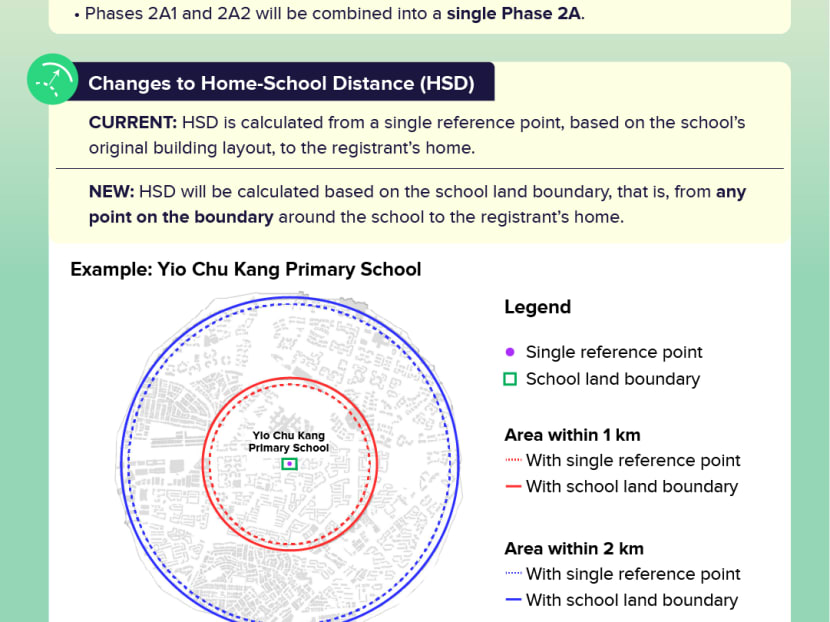Pri 1 registration spots for pupils living near school, but with no prior links, to double from 2022: MOE
SINGAPORE — From next year, the number of places reserved for incoming pupils under Phase 2C of the Primary 1 registration exercise will double from 20 to 40. This registration phase is for children who live closest to a school but do not have links with it such as a parent being an alumnus.

Changes to the Primary 1 registration exercise will apply to children starting primary school education in 2023.
- The number of places reserved for pupils under Phase 2C will increase from 20 to 40 in the 2022 Primary 1 registration exercise
- In recent years, competition has intensified for children who live near the school but do not have links to it
- Phases 2A1 and 2A2 of the exercise will be merged into a single phase from 2022
- From 2022, the “home-school distance” will be calculated from any point on the boundary around the school to the registrant’s home
SINGAPORE — From next year, the number of places reserved for incoming pupils under Phase 2C of the Primary 1 registration exercise will double from 20 to 40. This registration phase is for children who live closest to a school but do not have links with it such as a parent being an alumnus.
Phases 2A1 and 2A2 will be merged into a single Phase 2A from next year as well, the Ministry of Education (MOE) said on Thursday (Sept 9).
Phase 2A1 gives priority admission to children whose parents are members of the school alumni or advisory or management committee. Phase 2A2 is for children in MOE Kindergartens under the purview of a primary school, have siblings who studied in that primary school, or parents who had attended or now work at the school.
The changes will apply to children starting Primary 1 in 2023.
The ministry already said in March that it was reviewing the Primary 1 registration framework to help more children obtain a place near their home in Phase 2C, the fifth of seven phases in the yearly registration exercise.
“This is in the educational interest of the child, to help them spend less time travelling and have more time to pursue other interests as well as for the convenience of the family,” MOE said in a statement.
In a media briefing on Thursday, it said the review showed that there was no perfect solution because increasing the number of places for one group will result in fewer places for another.
However, during its consultations, it found that stakeholders broadly felt that the ministry should try to keep the admissions system open and allow those who live near a primary school to have better access.
That is why the review focused on Phase 2C.
Late last month, TODAY’s Big Read feature explored how the yearly Primary 1 registration exercise, with seven phases and a multitude of rules, had become a major source of stress and consternation for parents.
MORE DEMAND FOR PLACES
MOE said that competition for places under Phase 2C had intensified in recent years.
This year, about one in three schools balloted in Phase 2C in the category for Singapore citizens living within 1km of a school.
This is an increase from one in four schools that balloted in this category seven years ago.
The latest change will benefit children applying for admission to 32 of the 64 primary schools that balloted in the category this year.
These 32 schools had 40 or fewer places at the start of Phase 2C in the latest exercise, MOE said. They form slightly less than 20 per cent of all schools but are where competition is probably most intense.
Education Minister Chan Chun Sing said that in recent years, the Government has observed that the number of students who enrolled in a school near their homes with which they have no affiliation has declined.
A balance, he said, needs to be struck between building a strong community for schools and providing convenience for children and their families.
“It is not an easy balance to strike, and there is certainly no perfect balance. But we believe that it is timely to take another step towards ensuring our schools remain open to a diverse profile of children,” he wrote on Facebook.
Phase 2B, which prioritises parent volunteers or parents endorsed by a church or clan connected to the school, will continue to have 20 reserved places.
In addition, a third of remaining vacancies at the end of Phase 2A2 will be allocated to Phase 2B and two-thirds to Phase 2C, MOE said.
MERGING OF PHASES 2A1, 2A2
Phase 2A1 was rolled out in 1999 to encourage stronger alumni and community support for schools but, over time, more stakeholders such as former students and alumni associations have been contributing actively to the schools.
As such, it was timely to review the differentiation policy among stakeholders in Phases 2A1 and 2A2, MOE said.
The increase in reserved places for Phase 2C, moreover, will result in fewer places in the earlier phases.
“We expect that several schools would end up with relatively few or even no places left for Phase 2A2 registrants if we continue to maintain the differentiation of priority between Phase 2A1 and Phase 2A2 registrants,” MOE said.
Merging the two phases will ensure that those who apply under Phase 2A2 will have a chance to register under Phase 2A.
It will also better achieve the objective of providing priority admission for MOE Kindergarten children to support their transition to Primary 1, MOE said.
Phase 2A1 registrants will continue to be able to register under Phase 2A.
During the press briefing, the ministry said that during its consultations with alumni associations on the merging of the phases, some requested that MOE consider other solutions.
Even so, MOE said that there was broad agreement among the associations that the move would be good for the education system.
CHANGES IN CALCULATING DISTANCE
The ministry is also updating how it calculates the “home-school distance”, which determines whether households are within 1km or 2km of primary schools.
Right now, this is calculated from a single reference point, based on the school’s original building layout, to the home of the registrant. There is no change to the reference point even if the school building layout had changed significantly over the years.
From next year’s registration exercise, however, the distance will be calculated from any point on the boundary around the school, also known as the "school land boundary", to the registrant’s home.
MOE said that the boundary was less likely to change over time, providing a more stable basis to compute the distance to a registrant’s home.
The changes to the calculation method will result in a “slightly larger” coverage of residential addresses within 1km and 2km of all primary schools but will have no bearing on most registrants, MOE added.
Three primary schools will, however, see a small number of registrants shifted to a further home-to-school distance category. These are Cedar Primary School in Upper Serangoon, Maris Stella High School in Bartley and Marymount Convent School near Toa Payoh.
This is because their original reference points are outside the school land boundary as a result of significant upgrading or rebuilding work.
MOE said that the small number of households affected by this change would be allowed to retain their original distance to the school for next year’s registration exercise as a one-off transitional arrangement.












